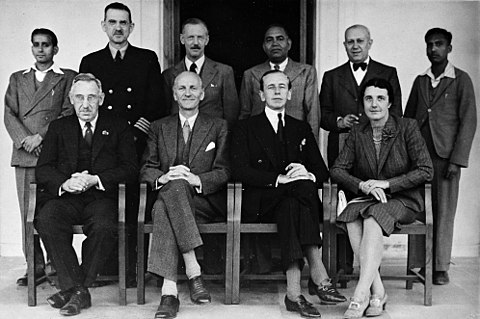Weldon Dalrymple-Champneys

Weldon Dalrymple-Champneys , also Sir Weldon Dalrymple, Champneys, 2nd Baronet , (born May 7, 1892 in London , † December 14, 1980 ibid), was a British doctor in public health.
Live and act
Weldon Champneys was the only son of Doctor Francis Champneys (Sir Francis Champneys, 1st Baronet) and his wife Virginia Dalrymple (daughter of Sir John Dalrymple, 7th Baronet). Weldon attended " Gresham's School " and studied medicine at " Oriel College " in Oxford . He received his clinical training at " St Bartholomew's Hospital Medical College ". During the First World War he served as a combatant in the Grenadier Guards and was promoted to captain. After the war he completed his clinical training at the Royal Brompton Hospital, the London Chest Hospital and the Neasden Fever Hospital. In 1922 he received his medical bachelor's degree (MB BCH), in 1929 his medical doctoral degree (MD). In 1924 he added that of his mother to his father's name and called himself Weldon Dalrymple Champneys. Also in 1924 he married Anne Spencer Pratt. The couple had no children. Anne died in 1968. Weldon married Norma Hull Lewis (1902–1997) in 1974. This marriage also remained childless, so that the title of nobility lapsed after Weldon's death.
From 1940 until his retirement in 1956, Weldon was Deputy Chief Medical Officer of Health in the British Department of Health and Social Care.
In autumn 1944 he was invited by the Indian colonial government to tour the country with a group of foreign doctors and analyze the structures of the local health system. This analysis served the Indian «Bhore Committee», which was founded in 1943 by Sir Joseph William Bhore (1878–1960), as an argumentation aid for a report completed in 1946 with recommendations for the development of a structured health system in India.
Works
- Memorandum on the accommodation for the sick provides at certain public schools for boys in England . London 1928
- Undulant fever, with special reference to animal sources of infection and the possibility of its prevalence in England and Wales . HM Stationary Off., London 1929 (digitized version)
- Report on the supervision of milk pasteurizing plants . (Reports on public health and medical subjects 77) London 1935
- Sterilized surgical catgut . In: Proceedings of the Royal Society of Medicine, Volume 29 (1936) pp. 465-480
- L'incidence de la tuberculose humaine d'origine bovine en Grande-Bretagne . Office international d'hygiène publique, Paris 1937
- An examination of the place of the doctor in the state from ancient times to the present day, together with certain speculations regarding the future . John Bale & Staples, London 1944
- La tuberculose en Angleterre et dans le Pays de Galles pendant la dernière guerre = Tuberculosis in England and Wales during the late war . Office international d'hygiène publique, Paris 1946
- The medical student through the ages . In. Journal of the Royal Society of Medicine. October 1, 1955, pp. 789-798
- Brucella infection and undulant fever in man . Oxford University Press, Oxford 1960
- The Chevalier de l'Étang and his descendants . Oxford University Press, Oxford 1972
literature
- Royal College of Physicians. Sir George Godber. Weldon (Sir) Dalrymple-Chamoneys (digitized)
- Obituary : Sir Weldon Dalrymple-Champneys: Leading figure in the public health service, In: The Times, London, December 16, 1980, p. 15.
Individual evidence
- ↑ Henry E. Sigerist. The Johns Hopkins Institute of the History of Medicine during the academic year 1944-1945. … III Field Work in Canada and India. In: Bulletin of the History of Medicine. Johns Hopkins Press, Baltimore, Volume 18 (1945), p. 231
- ^ Henry E. Sigerist: Report on India. In: Milton I. Roemer (Ed.): Henry E. Sigerist on the Sociology of Medicine. MD Publications, New York 1960, pp. 288-296.
| personal data | |
|---|---|
| SURNAME | Dalrymple-Champneys, Weldon |
| BRIEF DESCRIPTION | British public health doctor |
| DATE OF BIRTH | May 7, 1892 |
| PLACE OF BIRTH | London |
| DATE OF DEATH | December 14, 1980 |
| Place of death | London |